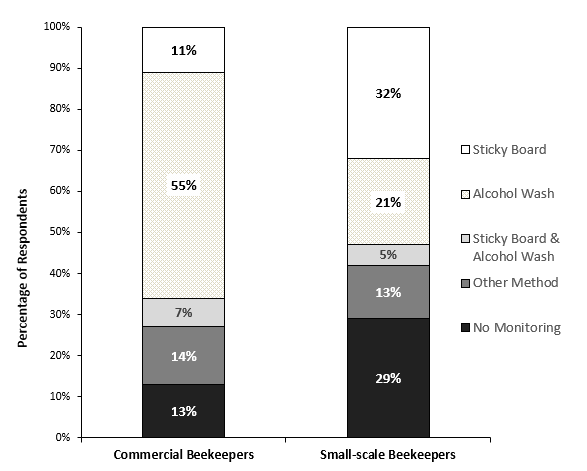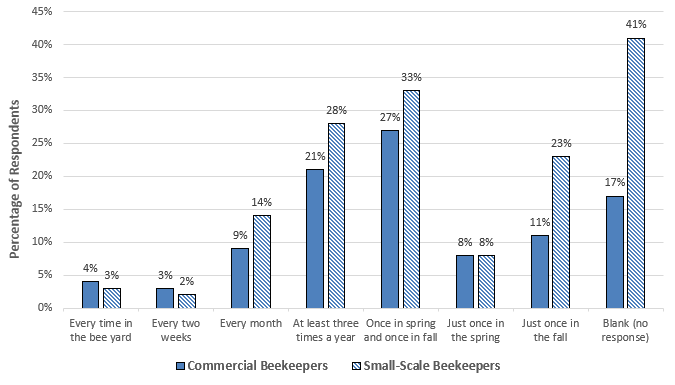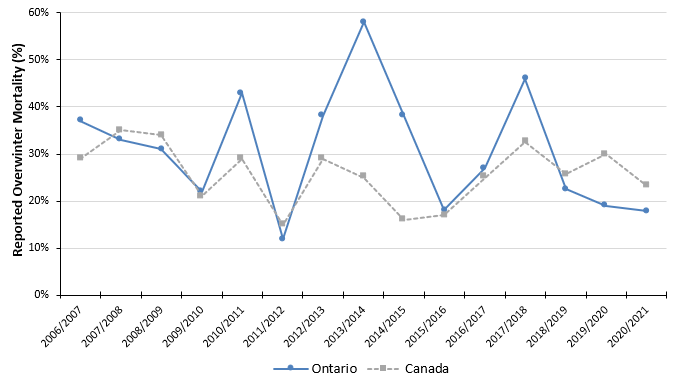2021 Apiculture winter loss report
2021 honey bee colony winter mortality
Overwinter mortality for 2020-2021 for commercial beekeepers operating in Ontario was estimated to be 18%, down from the 19% estimated for the winter of 2019-2020.
The estimate for commercial beekeepers in Ontario was approximately 19% less than the estimated loss reported for small-scale beekeepers (37%).
The 2021 estimation for honey bee loss averaged between all of Canada was 23%.
Who we surveyed
In the spring of 2021, the survey was distributed via email to:
- 252 registered commercial beekeepers (defined as operating 50 or greater colonies)
- 400 randomly selected registered small-scale beekeepers (defined as operating 49 or fewer colonies)
Due to the COVID-19 pandemic, the survey was sent electronically to beekeepers who provided the Ministry of Agriculture, Food and Rural Affairs (OMAFRA) with their email address.
The survey is voluntary and all responses are self-reported by beekeepers. Data is not verified by OMAFRA or any other independent body.
Responses were received from 90 commercial beekeepers and 138 small-scale beekeepers which represents 35% of beekeepers who received the survey.
Of the beekeepers who were registered in Ontario as of December 31, 2020, responses were received from 43% of commercial beekeepers representing 42,467 colonies and from 5% of small-scale beekeepers representing 1,084 colonies (Tables 1 and 2). Combined, the responses represent 43% of the total number of registered colonies.
| Beekeeping regions | # of commercial beekeeper respondents | % of commercial beekeeper respondents | # of small-scale beekeeper respondents | % of small-scale beekeepers respondents |
|---|---|---|---|---|
| Central | 33 | 37% | 40 | 29% |
| East | 13 | 14% | 35 | 25% |
| North | 6 | 7% | 19 | 14% |
| South | 31 | 34% | 35 | 25% |
| Southwest | 7 | 8% | 9 | 7% |
| Beekeeper type | # of full-sized colonies put into winter in fall 2020 | # of viable overwintered colonies as of May 15, 2021 | # of non-viable colonies as of May 15, 2021 | Overwinter mortality (%) |
|---|---|---|---|---|
| Commercial | 42,467 | 34,924 | 7,543 | 17.8% |
| Small-scale | 1,086 | 687 | 399 | 36.7% |
Results
The estimated overwinter honey bee mortality and the number of respondents varied by beekeeping region (Table 3). The majority of commercial beekeepers who responded to the survey were from the central and south beekeeping regions. These areas are known to have the greatest beekeeping activity. Responses from small-scale beekeeping operations were largely from the central, east and south beekeeping regions (Table 1).
Commercial beekeepers reported the greatest losses in the north region while small-scale beekeepers reported the highest losses in the south region (Table 3). Overall, mortality during the 2020-2021 winter was approximately 18.9 percentage points lower with commercial than small-scale beekeepers (Table 2).
| Beekeeping region | # of commercial beekeeper respondents | Commercial beekeeper overwinter mortality (%) | # of small-scale beekeeper respondents | Small-scale beekeeper overwinter mortality (%) |
|---|---|---|---|---|
| Central | 33 | 18.7% | 40 | 36.7% |
| East | 13 | 13.4% | 35 | 39.6% |
| North | 6 | 23.6% | 19 | 32.1% |
| South | 31 | 16.5% | 35 | 40.4% |
| Southwest | 7 | 22.5% | 9 | 26.4% |
| Total | 90 | 17.8% | 138 | 36.7% |
When respondents were grouped by operation size (number of colonies managed), the honey bee mortality during the winter of 2020-2021 ranged from 14.6% to 38.2% (Table 4). Beekeepers operating >1,000 colonies reported fewer honey bee colony losses (14.6%) than all other beekeeping operation sizes. The greatest number of survey respondents had beekeeping operations with fewer than 10 colonies and this group reported the second highest overwinter honey bee mortality of 33.8%.
This general trend showing beekeepers with the highest number of colonies (501-1,000 and >1,000) having the lowest losses (18.4% and 14.6% respectively) and beekeepers with the lowest number of colonies (<10 and 10-49) having the highest losses (33.8% and 38.2% respectively) is consistent with the trend of commercial beekeepers demonstrating much lower winter loss than small-scale beekeepers (Table 2).
This is the second year in a row where such a large difference in the level of winter loss between commercial and small-scale beekeepers has been reported. This may indicate that commercial beekeepers may have better training, more resources or more experience. However, this may also be an oversimplification of the data as it does not account for the variability in beekeeping practices employed between small-scale beekeepers or the number of respondents by operation size. Whatever the reason for the disparity in winter loss numbers between beekeeper type, this data should be considered for targeting of messaging and training for beekeepers while keeping in mind that management practices and environmental conditions may change and there is a need for both commercial and small-scale beekeepers to be well trained and up to date with credible, regional information and best management practices.
| # of respondents | # of colonies reported in the fall of 2020 | Overwinter mortality (%) |
|---|---|---|
| 106 | <10 | 33.8% |
| 32 | 10-49 | 38.2% |
| 57 | 50-200 | 29.4% |
| 15 | 201-500 | 20.1% |
| 7 | 501-1,000 | 18.4% |
| 11 | >1,000 | 14.6% |
Main factors of bee mortality
Beekeepers were asked to report on what they believed were the main factors contributing to their overwinter honey bee mortalities; they were able to select as many reasons as they felt were applicable. These opinions may be based on observable symptoms or beekeeper experience, judgement or best estimate.
The most commonly reported factors influencing overwinter mortality (Table 5) by commercial beekeepers included:
- poor queens
- weak colonies in the fall
- ineffective varroa control
The most commonly reported factors influencing overwinter mortality (Table 5) by small-scale beekeepers included:
- weak colonies in the fall
- don’t know
- ineffective varroa control
28% of commercial beekeepers and 14% of small-scale beekeepers selected “other” for their suspected cause of colony loss. It is noted that 11% and 4% of the ‘other’ responses were attributed to suspected pesticide poisonings by commercial and small-scale beekeepers respectively.
| Suspected cause(s) of colony loss | % of commercial beekeepers reporting | % of small-scale beekeepers reporting |
|---|---|---|
| Poor queens | 44% | 12% |
| Weak colonies in the fall | 37% | 25% |
| Weather | 23% | 14% |
| Starvation | 18% | 7% |
| Ineffective varroa control | 32% | 17% |
| Other | 28% | 14% |
| Don’t know | 19% | 18% |
| Nosema | 7% | 4% |
Management practices for pests and disease
Varroa mites (Varroa destructor)
In this survey beekeepers were asked how they monitored for varroa mite infestations (Figure 1) and which treatments were used at the beginning (spring) and the end (fall) of the 2020 beekeeping season (Table 6).

Accessible description for Figure 1
Proportion of beekeepers monitoring for varroa mites
Of the beekeepers who responded to the varroa mite monitoring question, 87% of commercial beekeepers and 71% of small-scale beekeepers stated they monitor for varroa mite infestation in their colonies. Of those, a number of monitoring methods were used, the most common being either an alcohol wash or a sticky board.
Some beekeepers used more than 1 method to monitor for varroa mites. When the response “other” was selected, some beekeepers reported that they visually checked their colonies for varroa mites or used the “sugar shake” method. However, neither of these methods is recommended or recognized as effective, as visually checking for mites is not proven to yield usable information and the sugar shake method can be unreliable and it is not tied to established thresholds for Ontario.
From the data, it appears that most (87%) of the commercial beekeepers represented by this survey are monitoring for varroa mites. However, this figure is down from the 92% of commercial beekeepers who reported they were monitoring for varroa mites in the 2019-2020 season.
Conversely, it remains concerning that a high percentage (29%) of the small-scale beekeepers who responded to the survey reported no monitoring at all. This number represents a very high proportion of beekeepers in this category who are not monitoring for varroa mites. Ideally, 100% of beekeepers should monitor for varroa mites as monitoring, along with application of a treatment, is crucial for the management of this honey bee pest. Without the management of varroa mites, colonies are at a high risk of death and/or spreading varroa mites to other nearby colonies.
These results demonstrate the need for further education/training of beekeepers and further messaging on best management practices and integrated pest management.
Frequency of monitoring for varroa mites
It is encouraging to see from the survey data (Figure 2) that a good proportion of both commercial and small-scale beekeepers are sampling at least twice per season (on average 30%), and it is even more encouraging to see that many commercial and small-scale beekeepers are sampling even more frequently (3 times, every month, or every time in the bee yard). At the same time there is room for improvement for both categories of beekeepers. Monitoring frequently, particularly as the beekeeping season progresses, is one of the most important management practices beekeepers can do to ensure they are applying their varroa treatments in a timely manner and ultimately preventing damaging levels of varroa from occurring.
This is the second year Ontario included a question on the frequency of monitoring; this question was not included in the national Canadian Association of Professional Apiculturists’ survey.

Accessible description for Figure 2
Treatments used to control varroa mites
Ontario beekeepers use a variety of treatment options to manage varroa mites (Table 6). In spring of 2020, the most common method of varroa mite treatment reported by commercial beekeepers was Apivar®, while in fall of 2020 both Apivar® and oxalic acid were most commonly used by commercial beekeepers. Small-scale beekeepers indicated a preference for Apivar® and oxalic acid as well as Formic Pro and Mite Away Quick Strips™ over other forms of mite control. The least commonly used treatments by both commercial and small-scale beekeepers were Bayvarol®, ApiLifeVar and Hopguard II. CheckMite+™ was not used by any survey respondents. It should be noted that both of the treatments ApiLifeVar and Hopguard II were recently registered and are newly available to beekeepers in Ontario.
These results are encouraging as it demonstrates that Ontario beekeepers are likely rotating their miticides, which is an important strategy for delaying the onset of resistant populations of varroa mites. However, there may be some cause for concern from the data as the industry appears to be quite reliant on Apivar® as a control method for varroa mites. Development of resistance to amitraz (the active ingredient in Apivar®) may seriously restrict Ontario beekeepers’ ability to control varroa mites, resulting in increased mortality of colonies in Ontario. While other chemical options are available many of them are temperature dependent and this may factor into the timing and choice of treatment, depending on the weather conditions (formic acid) during a particular season in Ontario.
As amitraz resistance has been documented in varroa mite populations in the USA, it is important to monitor the status of amitraz in Canada. New compounds will be needed for varroa mite control in order to ensure there is a robust set of options available to beekeepers and to offer the opportunity to rotate treatments so that beekeepers can continue to incorporate effective integrated pest management practices in their beekeeping operation.
It should be noted that varroa mites in Ontario have established resistance (or reduced efficacy) to other compounds (for example, coumaphos, fluvalinate, flumethrin).
| Varroa mite treatment (active ingredient) | Spring 2020 % of commercial beekeepers | Spring 2020 % of small-scale beekeepers | Fall 2020 % of commercial beekeepers | Fall 2020 % of small-scale beekeepers |
|---|---|---|---|---|
| Apistan® (fluvalinate) | 7% | 2% | 6% | 4% |
| CheckMite+™ (coumaphos) | 0% | 0% | 0% | 0% |
| Apivar® (amitraz) | 32% | 20% | 46% | 23% |
| Thymovar (thymol) | 4% | 2% | 4% | 2% |
| ApiLifeVar (thymol and essential oils) | 1% | 0% | 1% | 0% |
| Bayvarol® (flumethrin) | 1% | 1% | 1% | 4% |
| 65% formic acid – 40 ml multiple application | 20% | 4% | 16% | 4% |
| 65% formic acid – 250 ml single application | 2% | 4% | 3% | 4% |
| Mite Away Quick Strips™ (formic acid) | 6% | 10% | 6% | 12% |
| Formic Pro (formic acid) | 13% | 17% | 26% | 20% |
| Oxalic Acid | 18% | 21% | 42% | 33% |
| Hopguard II (hop compounds) | 0% | 1% | 2% | 1% |
| Other | 3% | 5% | 2% | 3% |
| None | 19% | 25% | 2% | 7% |
Nosema spp. (N. apis and N. ceranae)
Over 90% of survey respondents indicated that nosema treatment was not applied in the spring of 2020 and approximately 90% of respondents did not treat for the disease in the fall of 2020 (Table 7).
| Nosema treatment | Spring 2020 % of commercial beekeepers | Spring 2020 % of small-scale beekeepers | Fall 2020 % of commercial beekeepers | Fall 2020 % of small-scale beekeepers |
|---|---|---|---|---|
| Fumagillin | 5% | 9% | 8% | 11% |
| Other | 1% | 0% | 1% | 0% |
| None | 94% | 91% | 90% | 89% |
American foulbrood (Paenibacillus larvae)
The majority of commercial beekeepers who responded to this survey question treated for American foulbrood (AFB) during spring 2020 (65%) and a little more than half treated during fall 2020 (58%) with oxytetracycline. By comparison, 25% of small-scale beekeepers reported treating for AFB in the spring and 26% of small-scale beekeepers treated in the fall (Table 8).
| American foulbrood treatment | Spring 2020 % of commercial beekeepers | Spring 2020 % of small-scale beekeepers | Fall 2020 % of commercial beekeepers | Fall 2020 % of small-scale beekeepers |
|---|---|---|---|---|
| Oxytetracycline | 65% | 25% | 57% | 25% |
| Tylosin | 0% | 0% | 1% | 1% |
| Lincomycin | 0% | 0% | 0% | 0% |
| Other | 0% | 0% | 0% | 0% |
| None | 35% | 75% | 42% | 74% |
Ontario’s overwinter mortality
The Canadian Association of Professional Apiculturists compiles overwinter mortality data provided by each province and publishes an annual report on national honey bee colony losses. Figure 3 compares Ontario’s overwinter mortality levels to that of Canada’s. The 2021 estimate for commercial beekeepers in Ontario (17.8%) was approximately 5% less than the estimation for bee loss averaged between all of Canada (23.2%).

Accessible description for Figure 3
Accessible image descriptions
Figure 1. Type of varroa mite monitoring method used by commercial and small-scale beekeepers in 2020.
Figure 1 shows the type of varroa mite monitoring method used by commercial and small-scale beekeepers in 2020. 11% of commercial beekeepers reported using the sticky board method, 55% used the alcohol wash method, 7% used both sticky board and alcohol wash, 14% used other methods, and 13% reported no monitoring for varroa mites. 32% of small-scale beekeepers reported using the sticky board method, 21% used the alcohol wash method, 5% used both sticky board and alcohol wash, 13% used other methods, and 29% reported no monitoring for varroa mites.
Figure 2. Frequency of varroa mite monitoring by commercial and small-scale beekeepers in 2020
Figure 2 shows the frequency of varroa mite monitoring by commercial and small-scale beekeepers in 2020. Small-scale beekeepers – 3% every time in bee yard, 2% every 2 weeks, 14% every month, 28% at least 3 times per year, 33% once in spring and once in fall, 8% just once in the spring, 23% just once in the fall, 41% blank (no response). Commercial beekeepers – 4% every time in bee yard, 3% every 2 weeks, 9% every month, 21% at least 3 times per year, 27% once in spring and once in fall, 8% just once in the spring, 11% just once in the fall, 17% blank (no response).
Figure 3. Overwinter mortality (%) reported by commercial beekeepers in Ontario (blue) and Canada (grey) from 2006-2007 to 2020-2021
Figure 3 shows the percentage of overwinter mortality reported by beekeepers in both Ontario and Canada from 2007 to 2021. The reported overwinter mortality in Ontario and Canada (respectively) was the following: 2007 – 37% and 29%; 2008 – 33% and 35%; 2009 – 31% and 34%; 2010 – 22% and 21%; 2011 – 43% and 29%; 2012 – 12% and 15%; 2013 – 38% and 29%; 2014 – 58% and 25%; 2015 – 38% and 16%; 2016 – 18% and 17%; 2017 – 27% and 25%; 2018 – 46% and 33%; 2019 – 23% and 26%; 2020 – 19% and 30%; 2021 – 18% and 23%.